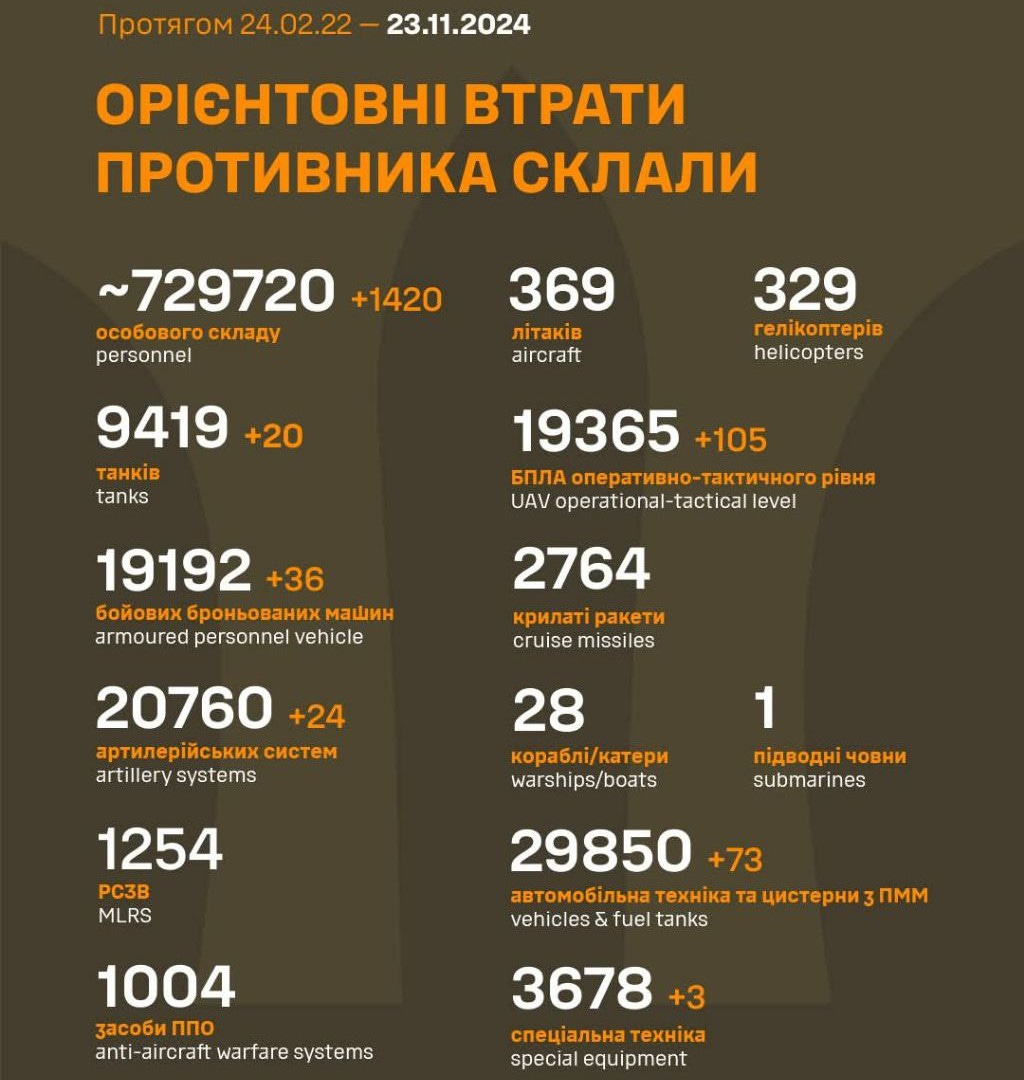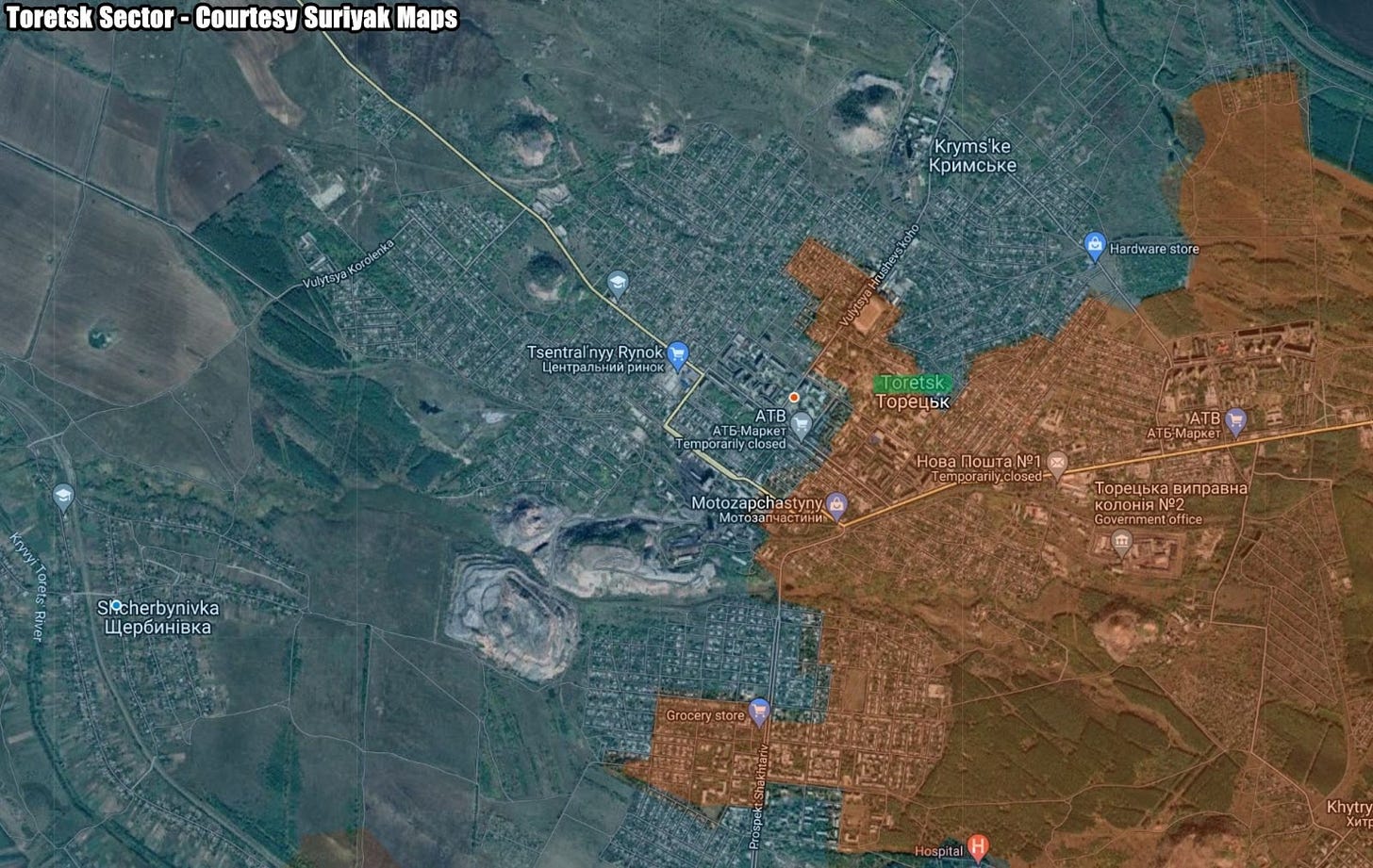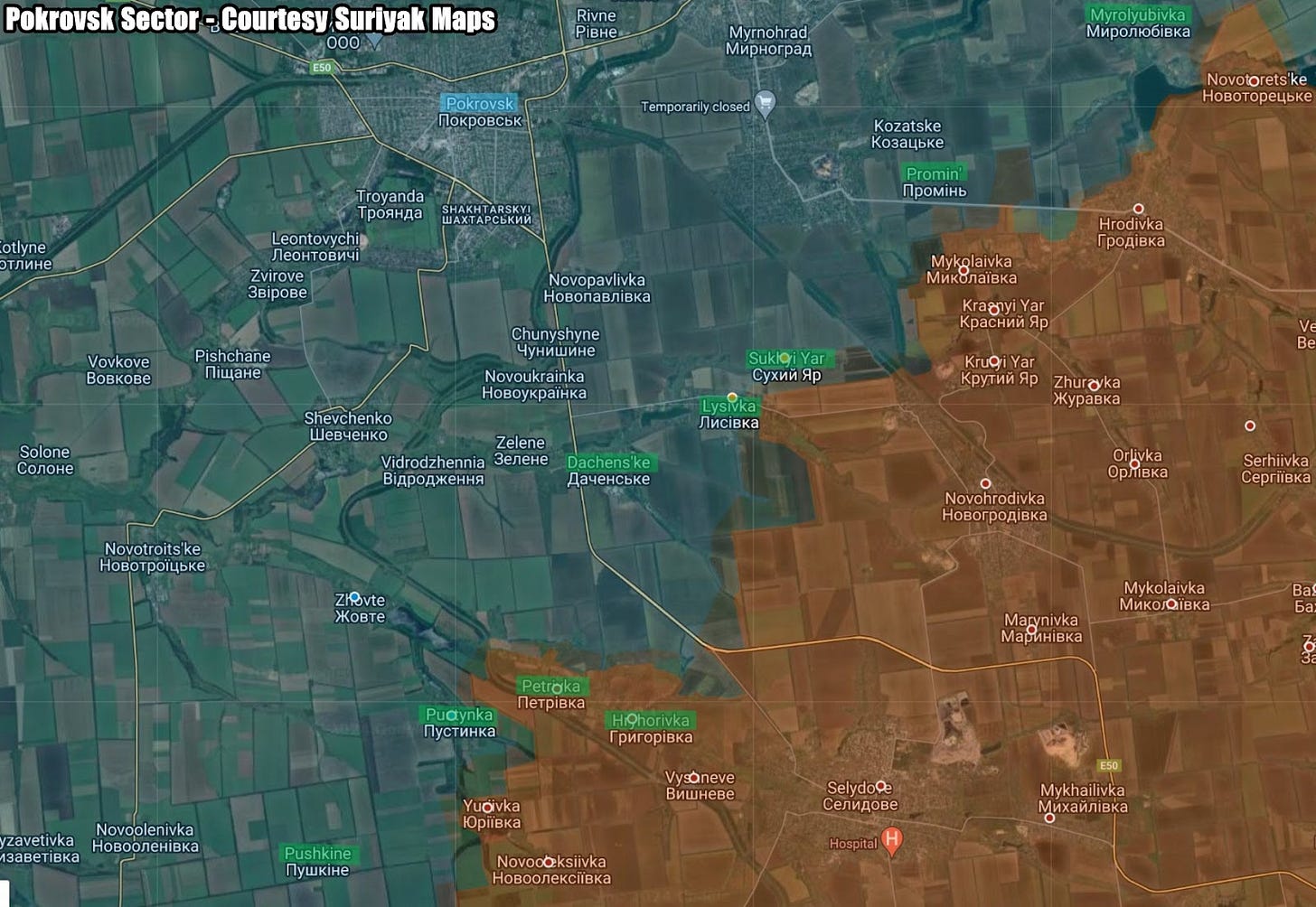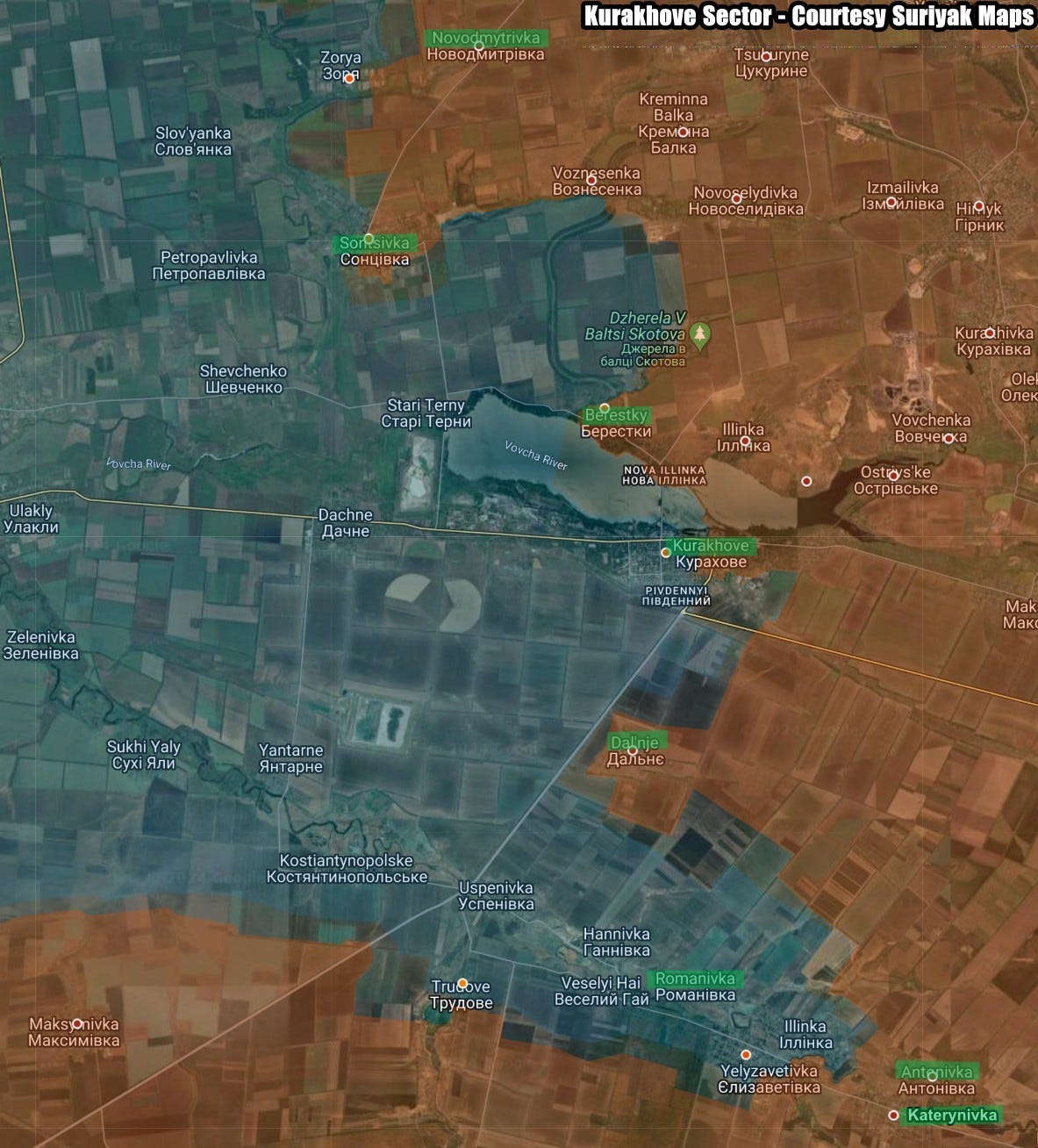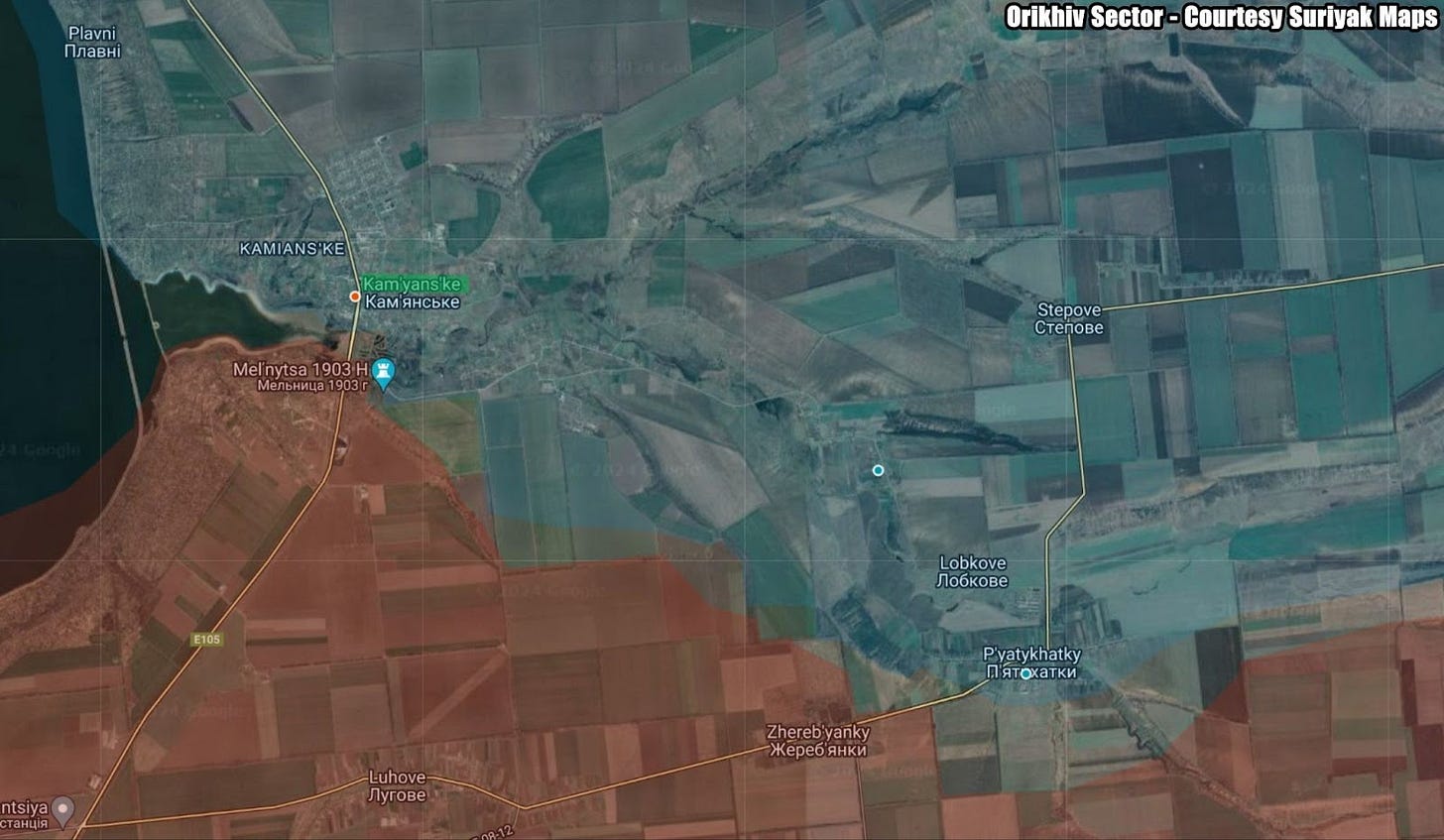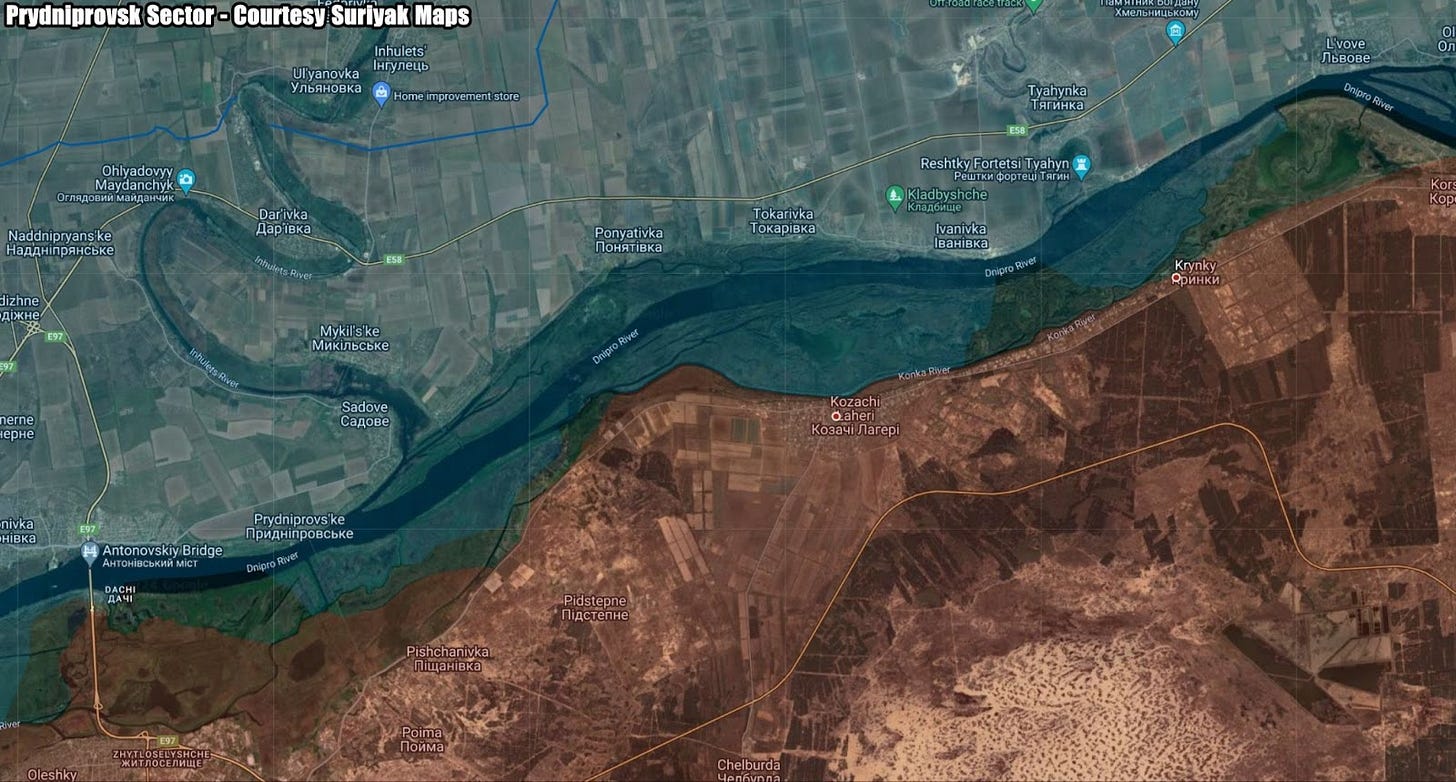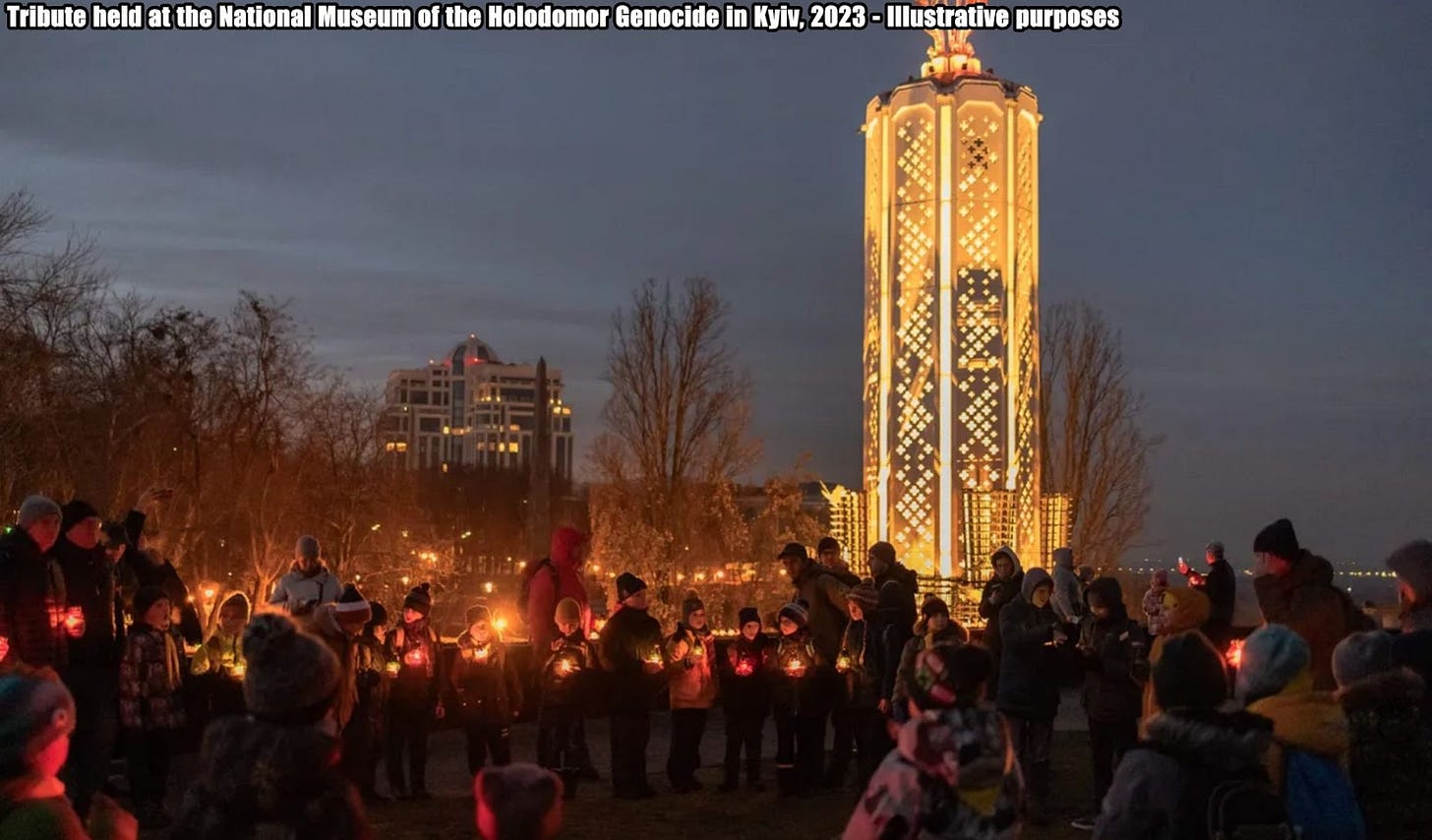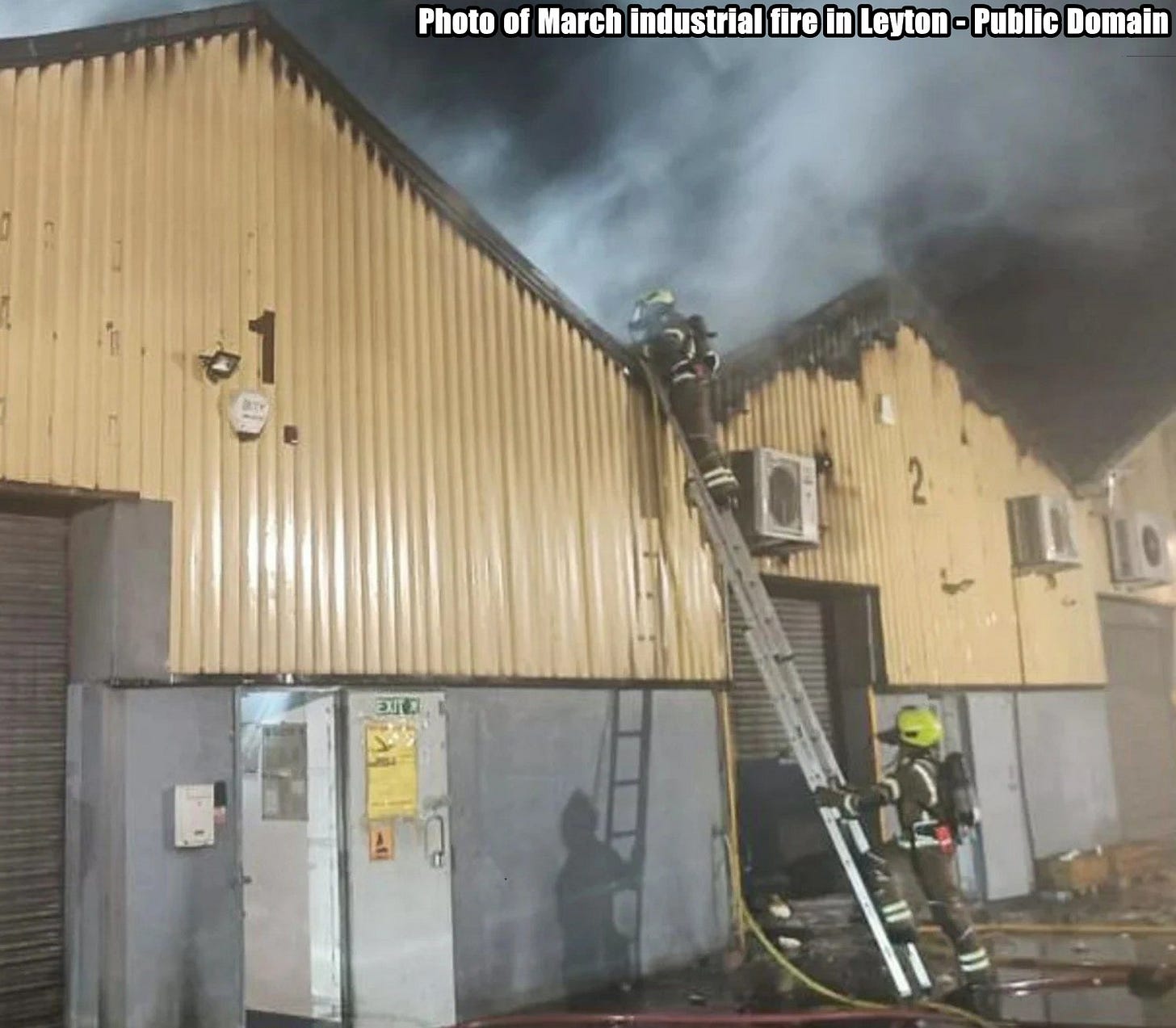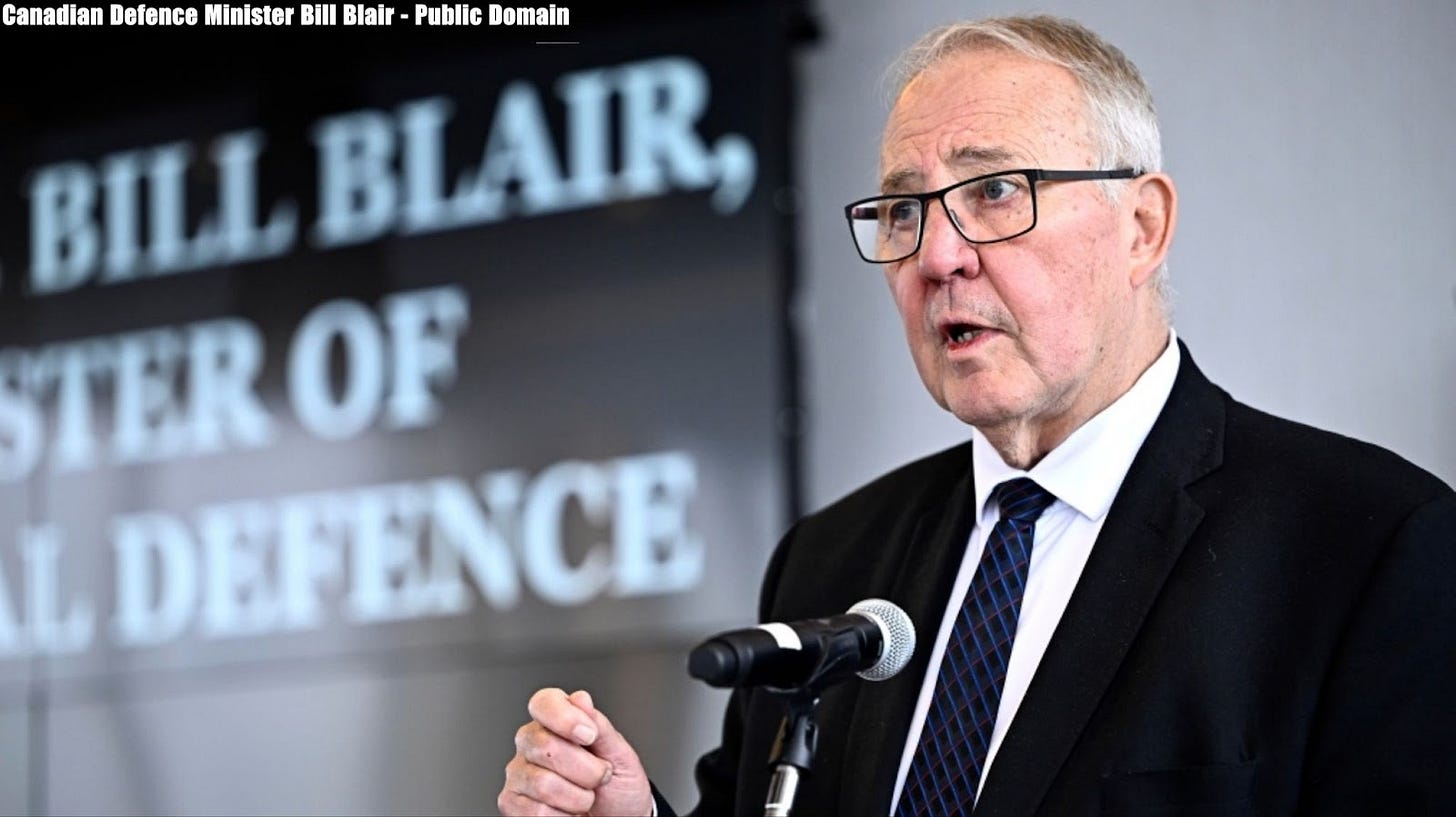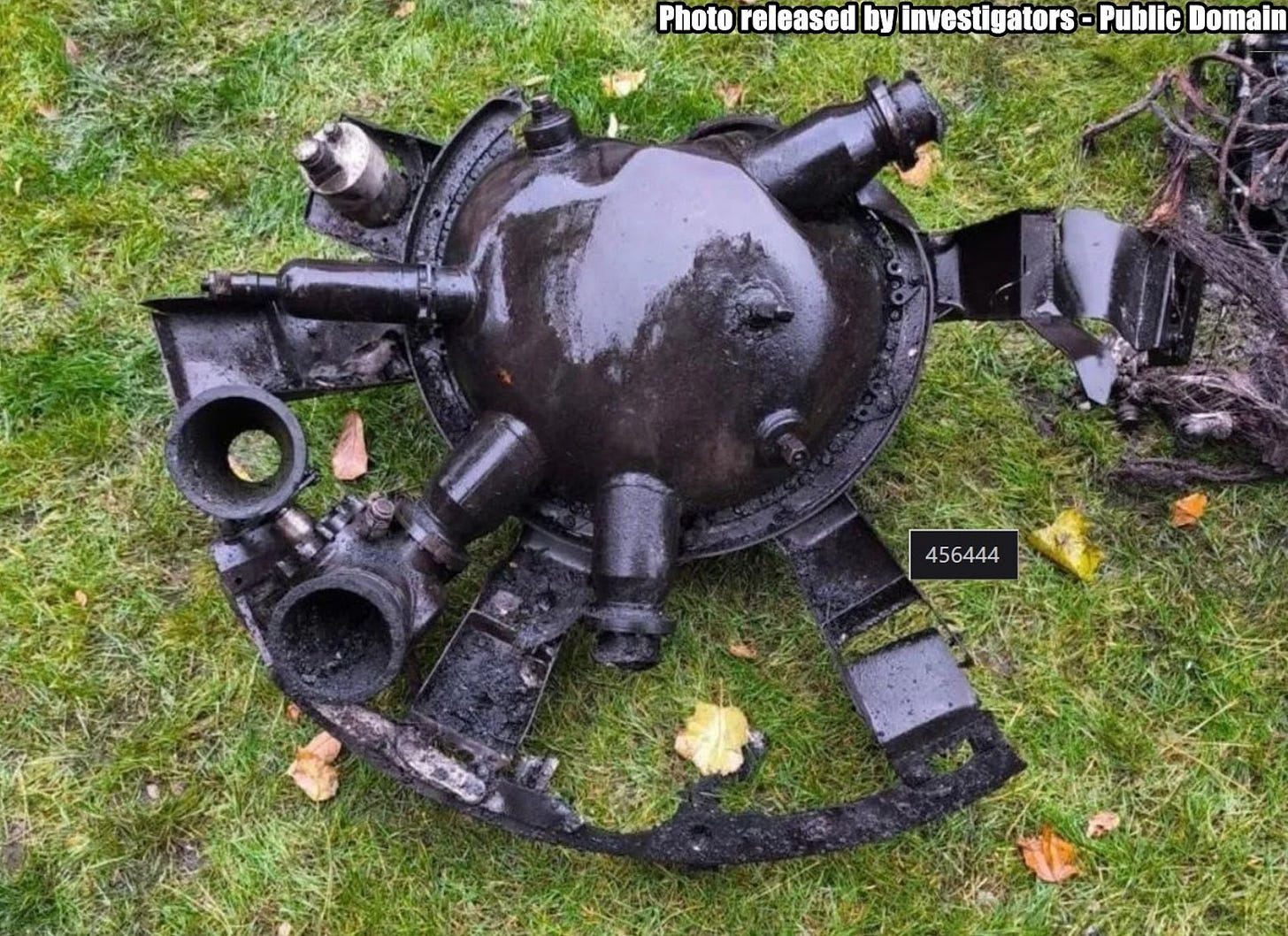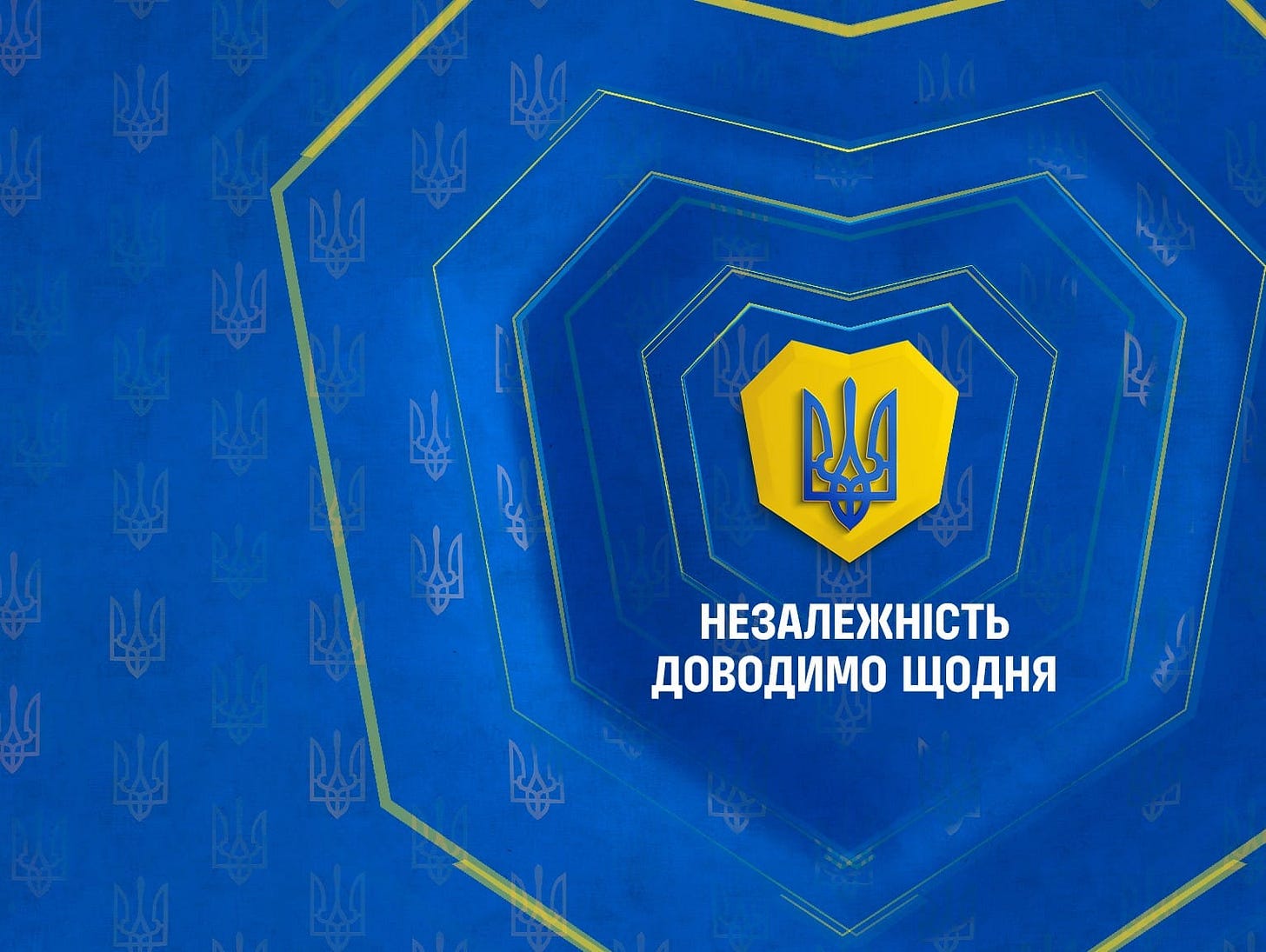Slava Ukraini! In early 2022 I began a Telegram channel aggregating news from a number of sources daily on the war in Ukraine. In June 2023 I began providing a daily draft for the Ukraine War Brief Podcast collecting news from over 70 sources daily, which formed the basis of the script. While the Podcast no longer exists I have continued to make this Brief available for my followers here on Substack for those who wish to keep up with the news from the war. A version of this Brief will also be made available on The People’s Media Substack for those who should choose to subscribe there.
All the latest news on the Russo-Ukraine War 6 days per week
ALONG THE CONTACT LINE
GSAFU Morning Report
The General Staff of the Armed Forces of Ukraine in its Operational Information update at 22:00 on Nov 22 stated that day 1004 of the full-scale invasion of the Russian Federation against Ukraine was about to begin.
During the past day, 187 combat engagements took place. Over the past 24 hours, the enemy carried out 2 missile strikes, 52 air strikes, 748 drone strikes and more than 3,900 artillery strikes across the positions of Ukrainian forces.
At the same time, Ukrainian soldiers continue to inflict losses in manpower and equipment on the occupying troops, exhausting the enemy along the entire front line and continue to disrupt the plans of Russian occupiers to advance deep into the territory of Ukraine.
The Air Force report for Nov 22 has finally been released.
During the current day from 01:30 on November 22, 2024, the invaders are attacking Ukraine with attack UAVs of the "Shahed" type and drones of an unspecified type from the Russian Eagle.
In total, the radio engineering troops of the Air Force of the Armed Forces of Ukraine identified and escorted 114 enemy air targets.
Aviation, anti-aircraft missile units, EW devices and mobile fire groups of the Air Force and the Defense Forces of Ukraine were involved in repelling the attack.
As of 5:30 p.m., anti-aircraft defence shot down 64 enemy drones, mainly in the centre of the country and in the northeastern regions.
41 unmanned aerial vehicles — lost in location, presumably due to active anti-aircraft defence of the Defense Forces, two more Russian UAVs left the airspace of Ukraine in the direction of Russia and Belarus.
The Russian Border Incursion
The Institute for the Study of War (ISW), a US based think tank, in its Nov 21 Russian Offensive Campaign Assessment reported that Russian forces continued assaults in the main Ukrainian salient in Kursk Oblast on Nov 21 and 22 but did not make confirmed advances. Russian milbloggers claimed that Russian forces advanced near Darino (southeast of Korenevo) and in forested areas near Olgovka (east of Korenevo) and Malaya Loknya (north of Sudzha), although ISW has not observed confirmation of these claims.
The commander of a Ukrainian platoon operating in Kursk Oblast reported that Russian forces are sending wounded personnel on infantry assaults in Kursk Oblast, and a Russian milblogger noted on Nov 21 that poor weather conditions have set in in Kursk Oblast. A Russian milblogger claimed that elements of the Russian 83rd Airborne (VDV) Brigade and 51st VDV Regiment (106th VDV Division) are attacking near Darino and Nikolayevo-Darino (just south of Darino). Russian forces also continued assaults north of Sudzha near Pogrebki and Orlovka and southeast of Sudzha near Plekhovo. A Russian milblogger claimed that Russian forces repelled Ukrainian mechanised assaults southeast of Korenevo near Novoivanovka and Darino.Elements of the Russian BARS-Kursk volunteer detachment are reportedly operating in Kursk Oblast.
Ukrainian outlet Suspilne reported on Nov 22, citing sources within the Ukrainian General Staff, that Russia has accumulated almost 60,000 troops in Kursk Oblast and that the Ukrainian General Staff currently assesses that Russian forces intend to push Ukrainian forces back across the international border into Sumy Oblast and conduct further offensive operations into Ukraine in order to create a "buffer zone" in Sumy Oblast. The sources stated that the Ukrainian military command assesses that the Ukrainian incursion into Kursk Oblast prevented Russian forces from launching a major offensive operation in Zaporizhia Oblast in recent months.
The Khortytsia operational-strategic group
(Responsible for the northeastern part of Ukraine. )
Kharkiv Sector: Over the last day Ukrainian Defense Forces repelled 10 Russian attacks in the area of Starytsya, Ohirtseve and Vovchansk.
Kupyansk Sector: Russian Forces carried out 6 offensive actions against Ukrainian defensive positions near Hlushkivka, Zahryzove and Zelenyi Hai.
Lyman Sector: Russian Forces carried out 18 offensive actions against Ukrainian defensive positions near Hrekivka, Makiivka, Terny and Torske.
Siversk Sector: In this sector, over the last day, there has been no significant change in the combat environment. Russia conducted several air strikes in the area.
Kramatorsk Sector: Russian forces carried out 4 offensive actions against Ukrainian defences in the vicinity of Chasiv Yar and Stupochky. 1 engagement continues.
Toretsk Sector: Over the last day Russian forces carried out 7 offensive actions with air support near Toretsk. 1 engagement continues.
The Tavria operational-strategic group
(Responsible for the central-eastern and southeastern part of Ukraine.)
Pokrovsk Sector : This sector saw the most intense fighting over the last day, Russian Forces carried out 40 offensive actions against Ukrainian defensive positions in the vicinity of Myrolyubivka, Promin, Sukhyi Yar, Lysivka, Dachenske, Petrivka, Hryhorivka, Pustynka and Pushkine. 4 engagements are ongoing.
Kurakhove Sector: Over the last day in this district Russia conducted 35 offensive actions in the vicinity of Novodmytrivka, Sontsivka, Berestky, Kurakhove, Dalnje, Romanivka, Katernyivka and Antonivka. 31 engagements are ongoing.
Vremivka Sector: Russian forces made 15 attempts to break through Ukrainian defences in the vicinity of Novodarivka [not shown on map] Rozdolne, Rozlyv, Sukhi Yaly, Kostiantynopolske and Trudove. 4 engagements are ongoing.
Orikhiv Sector: In this sector, over the last day, there has been no significant change in the combat environment. Russian forces made 1 unsuccessful attempt to dislodge Ukrainian units from their defensive positions near Kamyanske.
The Odesa operational-strategic group
(Responsible for Kherson, Qırım, (also known as Crimea) and the Black Sea.)
Prydniprovsk Sector: In this sector, over the last day, there has been no significant change in the combat environment. Russian forces made 4 unsuccessful attempts to dislodge Ukrainian units from their positions on the left bank of the Dnipro.
TEMPORARILY OCCUPIED TERRITORIES
Nothing major to report.
THE HOME FRONT
Ukraine Marks Holodomor Remembrance Day.
President Volodomor Zelensky marked Holodomor Remembrance Day on Nov. 23, honouring the victims of the Soviet man-made famine that killed an estimated three to five million Ukrainians. The Kyiv Independent reports.
The Holodomor occurred from 1932 to 1933 under Soviet dictator Joseph Stalin's rule. The Ukrainian government has called on the international community to recognize it as a genocide against the Ukrainian people.
On Holodomor Remembrance Day, Ukrainians traditionally light a candle at 4 p.m. and place it in their window to honour the memories of those who perished in the famine.
"They wanted to destroy us. To kill us. To subjugate us. They failed. They wanted to hide the truth and silence the terrible crimes forever. They failed," Zelensky wrote on X, formerly known as Twitter.
"They wanted to confuse us, mislead us, make us doubt—to forget, and in forgetting, to forgive. They failed."
Several of Ukraine's European allies also marked Holodomor Remembrance Day.
European Parliament President Roberta Metsola wrote that "Europe joins the people of Ukraine to remember and pay tribute (to the victims)."
"Russia continues what it started 91 years ago – trying to erase the Ukrainian nation from the Earth. Then via manmade famine, today with rockets, missiles, bombs, murders, rape, attacks on ports, energy facilities," Latvian Foreign Minister Baiba Braze wrote, noting that Latvia recognized the Holodomor as a genocide in 2008.
RUSSIAN WORLD
Russia Labels 172 Indigenous Groups as ‘Terrorist’ Organizations
Russia’s Supreme Court designated 172 indigenous groups as “terrorist” organisations, accusing them of lobbying for secession and supporting Ukraine’s military, The Moscow Times reports citing an announcement by the Prosecutor General’s Office onFriday.
Authorities claimed these groups are “structural subdivisions” of the Free Nations of PostRussia Forum, a Poland-based organisation founded in 2022. The forum describes itself as a platform advocating for the decolonization and fragmentation of Russia into 41 independent states.
“The organisation is led by self-proclaimed leaders of national-separatist movements who have fled abroad,” the prosecutor’s office said, alleging that their goal is to break Russia into smaller states under the influence of “unfriendly countries.”
Last year, the Prosecutor General’s Office labelled the Free Nations of PostRussia Forum an “undesirable organisation,” citing threats to Russia’s constitutional order and security. This designation criminalises any interaction with the forum.
The Supreme Court was scheduled to review the request to classify the forum as a “terrorist organisation” on Nov. 14.
Among the groups listed in Friday’s ruling are the Baltic Republican Party, the Ingria movement and the Free Yakutia Foundation — three organisations already labelled “extremist” by Russia’s Justice Ministry earlier this year.
Sargylana Kondakova, co-founder of the Free Yakutia Foundation, an Indigenous rights group from the republic of Sakha (Yakutia), said her organisation is not a part of the Free Nations of PostRussia Forum and rejected the Russian authorities’ description of its activities.
“This decision is defamation in its purest form,” Kondakova told The Moscow Times, referring to Friday’s “terrorist” designation. “We do not position ourselves as a nationalist separatist movement, we do not have a goal of partitioning the Russian Federation into multiple states.”
“We are an independent organisation that focuses on advocating for the rights of Indigenous people living in the republic of Sakha and combatting propaganda within the republic,” she added. “We do consider ourselves a decolonial movement because decolonizing Russia is a prerequisite for future peace.”
In June, the Supreme Court banned a vaguely defined “anti-Russian separatist movement” as “extremist,” though rights groups have noted the absence of any formally established organisation by that name.
Russia’s Justice Ministry later labelled 54 Indigenous groups and the U.S.-based Free Russia Foundation as “extremist” organisations.
Putin says Russia to continue 'testing' Oreshnik hypersonic missiles
During a televised meeting with military chiefs, President Vladimir Putin said Russia would continue testing its new Oreshnik hypersonic missiles DW reports.
He said Russia would begin "serial production" of the missile and praised the "particular strength of this weapon and its power."
"We will continue these tests, including in combat conditions, depending on the situation and character of the security threats posted to Russia," Putin said.
That comes a day after Putin said Russia had fired an Oreshnik missile at a Ukrainian military facility.
Russian officials say the launches are in response to the US and the UK authorization for Kyiv to strike targets within Russian territory using longer-range missiles.
INTERNATIONAL NEWS
Putin’s Assassination Targets Revealed in Declassified Memo
The Office of the Director of National Intelligence has released a long-classified memorandum shedding light on the targeted killings of Vladimir Putin’s political adversaries, following nearly eight years of persistent public records efforts. Bloomberg reports.
After nearly eight years of painstaking public records work, the Office of the Director of National Intelligence declassified a closely guarded memorandum related to the targeted assassinations of Russian President Vladimir Putin’s political foes.
Prominent critics of the Kremlin, and Putin in particular, seem to have a terrible habit of dropping dead under very suspicious circumstances. Some fall out of windows, bludgeon themselves to death, are poisoned or are said to have committed suicide in ways that defy logic. Anonymous US intelligence officials have long said they suspected that some of the mysterious deaths over the years were part of a campaign by Putin to assassinate his enemies. But internal US government documents that contained such explicit assertions have never really surfaced. Until now.
There have been a series of notable deaths over the years, beginning with the poisoning of ex-Russian spy Alexander Litvinenko in London in 2006. In 2015, there were two more: First came the shooting of Russian politician and vocal Kremlin critic Boris Nemtsov in Moscow. Then Putin’s former media czar, Mikhail Lesin, died in Washington, DC. Police said later that he succumbed to blunt force trauma after he fell down numerous times in a hotel room. A month after Lesin’s death, the House and Senate intelligence committees demanded answers.
Lawmakers tucked language inside a 2016 intelligence spending bill that tasked the Office of the Director of National Intelligence, or ODNI, with preparing a classified intelligence assessment for the committees. Specifically, it was to be about “the use of political assassinations as a form of statecraft by the Russian Federation since January 1, 2000.”
The directive from Congress, which the public was largely unaware of at the time, also called for ODNI to produce a list of prominent Russians, including politicians, businessmen and journalists, “that the intelligence community assesses were assassinated by Russian Security Services” and describe how and where they were killed.
The July 11, 2016 two-page document is titled, “Kremlin-Ordered Assassinations Abroad Will Probably Persist.” A footnote on page one says it only addresses assassinations abroad that have taken place “since Putin took power in 2000.” A letter ODNI notes that portions of it were withheld in order to protect classified foreign government information and classified intelligence activities.
The document, which says “Putin probably authorizes assassinations of high-profile figures abroad,” is blunt in its assessment:
A spokesperson for the Russian embassy in Washington, DC did not respond to a request for comment.
Below is a screenshot of the full two page report, redacted of course.
UK: Alleged Wagner plot targets Ukrainian-owned business
A man pleaded guilty to an arson attack on a Ukrainian-linked business in London. DW reports.
Prosecutors say Jake R. carried out the attack on behalf of Russia's Wagner paramilitary group. The group is classified as a terrorist organisation in the UK.
The man is one of six people charged over a March 20 fire at an industrial unit in Leyton, east London, which required 60 firefighters to extinguish. The target was a Ukrainian-owned business, according to prosecutors.
Fellow defendant Dylan E. previously admitted to aggravated arson. Prosecutors allege that he was in contact with a Wagner handler and orchestrated the attack.
Wagner fighters have been involved in fighting in Ukraine and are also present in Belarus and several African countries.
NASAMS air defence systems delivered to Ukraine from Canada.
A promised shipment of air defence systems purchased with the assistance of the Canadian government has reached Ukraine, the Kyiv Independent reported following an announcement by Canada's Defense Minister Bill Blair on Nov. 22.
The U.S.-made National Advanced Surface-to-Air Missile System (NASAMS) were first pledged to Kyiv back in January 2023. While Canada reportedly paid for the system, worth approximately $289 million, later in the spring, its delivery has been delayed. Blair said the NASAMS are now in Ukrainian hands.
"This ground-based air defence system will help Ukraine protect itself against destructive air attacks," Blair said.
"Canada's support for Ukraine is steadfast and we will continue to step up and build on our contributions to Ukraine in their fight against Russia's invasion."
President Volodymyr Zelensky previously said on Nov. 4 that Ukraine expected to receive the defence system "by the end of this year."
The NASAMS delivery arrives as Ukraine faces intensified Russian aerial attacks, including the recently deployed "Oreshnik" intermediate-range ballistic missile (IRBM), launched against Dnipro on Nov. 21.
Following the strike on Dnipro, Zelensky reiterated the importance of advanced Western air defence systems, directing Defense Minister Rustem Umerov to begin new talks with partners on acquiring additional equipment.
Ukrainian forces have been using NASAMS systems since November 2022, when the U.S. delivered the first batteries amid escalating Russian airstrikes.
MILITARY & TECH
Desperate decision by Putin grants Ukraine advanced missile technology access.
In a remarkable twist of events, critical components of Russia’s new missile have fallen into Ukrainian hands, offering experts an unprecedented opportunity to study the latest technology deployed by Moscow. Defence Blog reports.
This comes after Russian President Vladimir Putin announced on Thursday that Russia had conducted a strike using a new “ballistic missile with a non-nuclear hypersonic warhead” targeting the Ukrainian city of Dnipro.
The strike, described by Putin as a response to Ukraine’s use of American and British long-range weapons, marks a significant escalation. “Our missilemen called it ‘Oreshnik,'” Putin stated, claiming that Ukraine has “no means” to counter the new missile type.
The Pentagon has confirmed that Russia’s missile is based on the RS-26 Rubezh, referred to by NATO as SS-X-31, intercontinental ballistic missile model, and noted that the United States was briefly pre-notified through existing Nuclear Risk Reduction channels.
This strike represents the first instance globally of the use of such a class of weapon in active warfare. Despite the missile being reduced largely to fragments after the impact, Ukrainian experts, alongside international specialists, now have direct access to crucial elements of this advanced weaponry.
According to the Ukrainian military, even these fragments are of immense value for studying potential technological innovations, materials, and other components of interest—an effort that will be conducted in cooperation with Western partners.
Up until now, all prior tests of Russian intercontinental and intermediate-range ballistic missiles had been conducted in a controlled setting, with remnants exclusively recovered and safeguarded by Russian authorities. Each piece, down to the smallest screw, is typically classified at the highest levels and guarded rigorously against foreign intelligence efforts.
But now, due to Putin’s emotionally-driven decision, Western countries have been handed a window into some of Russia’s most closely guarded military technologies.
That’s it for today’s Brief folks if you would like to keep up with events in Ukraine daily please consider subscribing.
Feel free to share this update with your friends. Heroyam Slava!







